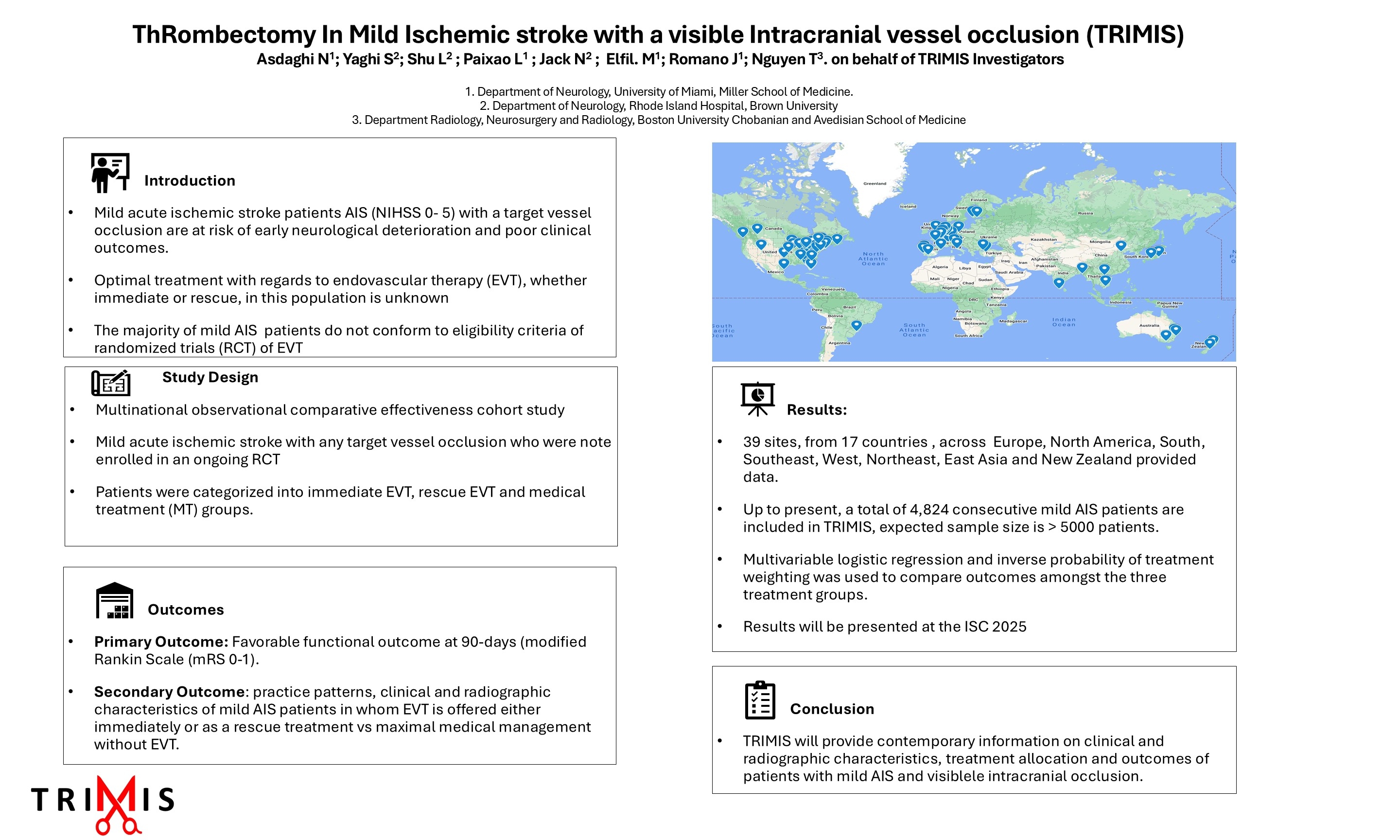Final ID: LB46
ThRombectomy In Mild Ischemic Stroke With a Visible Intracranial Vessel Occlusion (TRIMIS): An International Multicenter Observational Study
Abstract Body: Introduction: Patients with mild ischemic stroke and a visible intracranial artery occlusion are at risk of early neurological deterioration and poor clinical outcomes. The optimal acute treatment with regards to endovascular therapy (EVT) in this population is unknown. The ongoing mild stroke EVT randomized clinical trials (RCTs) are restricted by trial eligibility criteria; mainly including early presenting patients, with a large vessel occlusion, for whom immediate EVT is evaluated. This limits generalizability of their results to patients who present late, with distal or medium vessel occlusion in whom rescue EVT is routinely considered. Therefore, data from large multicenter collaborations are needed in parallel with RCTs, to inform clinical practice.
Methods: TRIMIS is a multinational observational comparative effectiveness cohort study of consecutive mild ischemic stroke due to a visible intracranial arterial occlusion, presenting within 24 hours from last seen normal (LSN) or without a known LSN in whom EVT could be considered. Patients were excluded if they were randomized into an ongoing RCT. Mild stroke was defined as NIHSS ≤ 5 at the time of initial hospital presentation. Patients were categorized into three groups of immediate EVT, rescue EVT and medical treatment (MT). The primary outcome is a favorable functional outcome at 90-days (modified Rankin Scale (mRS 0-1). Secondary outcomes include 90-day ordinal mRS and functional independence (mRS 0-2). Safety outcomes are symptomatic intracranial hemorrhage and 90-day mortality. Multivariable logistic regression and inverse probability of treatment weighting will be used to compare outcomes among the three groups, adjusting for age, pre-stroke mRS, baseline NIHSS, site of arterial occlusion, intravenous thrombolysis, time to treatment, and baseline ASPECTS.
Results: From January 2018 to September 2024, 4,824 patients from 39 sites, from 17 countries, across Europe, North America, South, Southeast, West, Northeast, East Asia and New Zealand The final sample size is expected to reach 5,000 patients by study completion date and results will be available at ISC.
Conclusion: TRIMIS will inform efficacy and safety outcomes of EVT versus MT in patients with mild ischemic stroke (NIHSS ≤5) with a visible intracranial arterial occlusion.
Methods: TRIMIS is a multinational observational comparative effectiveness cohort study of consecutive mild ischemic stroke due to a visible intracranial arterial occlusion, presenting within 24 hours from last seen normal (LSN) or without a known LSN in whom EVT could be considered. Patients were excluded if they were randomized into an ongoing RCT. Mild stroke was defined as NIHSS ≤ 5 at the time of initial hospital presentation. Patients were categorized into three groups of immediate EVT, rescue EVT and medical treatment (MT). The primary outcome is a favorable functional outcome at 90-days (modified Rankin Scale (mRS 0-1). Secondary outcomes include 90-day ordinal mRS and functional independence (mRS 0-2). Safety outcomes are symptomatic intracranial hemorrhage and 90-day mortality. Multivariable logistic regression and inverse probability of treatment weighting will be used to compare outcomes among the three groups, adjusting for age, pre-stroke mRS, baseline NIHSS, site of arterial occlusion, intravenous thrombolysis, time to treatment, and baseline ASPECTS.
Results: From January 2018 to September 2024, 4,824 patients from 39 sites, from 17 countries, across Europe, North America, South, Southeast, West, Northeast, East Asia and New Zealand The final sample size is expected to reach 5,000 patients by study completion date and results will be available at ISC.
Conclusion: TRIMIS will inform efficacy and safety outcomes of EVT versus MT in patients with mild ischemic stroke (NIHSS ≤5) with a visible intracranial arterial occlusion.
More abstracts on this topic:
A ChatGLM-based stroke diagnosis and prediction tool
Song Xiaowei, Wang Jiayi, Ma Weizhi, Wu Jian, Wang Yueming, Gao Ceshu, Wei Chenming, Pi Jingtao
10-Year Trends in Last Known Well to Arrival Time in Acute Ischemic Stroke Patients: 2014-2023Ferrone Nicholas, Sanmartin Maria, O'hara Joseph, Jimenez Jean, Ferrone Sophia, Wang Jason, Katz Jeffrey, Sanelli Pina
Readers' Comments
We encourage you to enter the discussion by posting your comments and questions below.
Presenters will be notified of your post so that they can respond as appropriate.
This discussion platform is provided to foster engagement, and simulate conversation and knowledge sharing.
You have to be authorized to post a comment. Please, Login or Signup.
Rate this abstract
(Maximum characters: 500)

